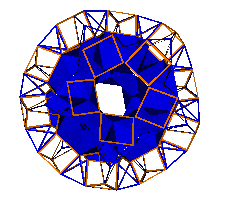
In a further attempt to illustrate the interior of this toroid, the image below simply shows the antiprismatic faces surrounding the dodecahedron, or in Stewart's terminology, the 12 S5(D5) section.
Chapter 15 of Professor B.M. Stewart's "Adventures Among the Toroids" (ISBN 0-686-119 36-3), focuses on toroids with a truncated dodecahedral convex hull.
Each of the decagonal faces of a truncated dodecahedron (T5) can be aligned with the pentagonal faces of a dodecahedron (D5). These faces can then be joined by a combination of a pentagonal cupola (Q5) and a pentagonal antiprism (S5).
This gives rise to a family of toroids of the form T5 / a Q5S5(D5) where 2>=a>=12.
The "Gem" of this family is the beautiful toroid T5 / 12 Q5S5(D5) with genus p=11.
Stewart's observations about this toroid include the following:
"the intersection of this toroid with its convex closure is not a network of faces ... but is a complex of 20 triangular faces, isolated in appearance, but each connected from every vertex at a sketeton edge"
"despite its dodecahedral appearance, the toroid is made up entirely of square and triangular faces."

In a further attempt to illustrate
the interior of this toroid, the image below simply shows the antiprismatic
faces surrounding the dodecahedron, or
in Stewart's terminology, the 12 S5(D5) section.
Cross sections of this toroid are also of interest. Many of the vertices of the toroid lie in distinct planes. These are shown on the diagram below. Two pairs of planes are shown, labelled L1- L1' and L2 - L2'.
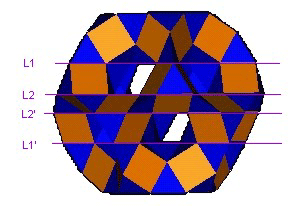
The images below link to
two models of the toroid cut at the L1 and L2 planes respectively
with the edges in the relevant planes highlighted in yellow. Note
the central pentagon on the left hand image, the edges shown here are those
joining two anti-prisms, both of which have been removed by the slicing
operation.
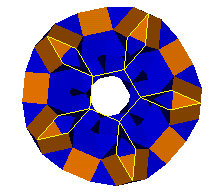 |
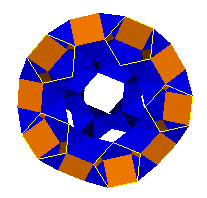 |
Note that the vertices on the L2 plane form regular pentagons. These can be added to the toroid to form a non convex toroid of genus p=6.
A fascinating slice of the original toroid can also be generated by taking the area between the L2 and L2' planes. This is itself a regularly faced toroid of genus p=1. .
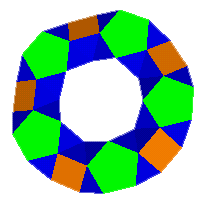
The original toroid can
be thought of as six of these 'rings' connected by the icosahedral (i.e.
triangular) faces of the truncated dodecahedron.
The pentagonal faces are identical to those which would be formed had the truncated dodecahedron and the central dodecahedron been linked by pentagonal rotundas. The size of the rotundas however means that they interfere. To link corresponding faces with a rotunda prevent the use of a further linkage (by either a rotunda or by a cupola/anti-prism) at any of the neighbouring decagonal faces. An example of a "T5" toroid containing a rotunda is this T5 / 6Q5S5 R5 (D5).
As an aside: A 'great' version of this figure also exists.
The model linked (here) shows the frame of the original toroid, with the sixty pentagonal "faces" superimposed. The image below (and linked model) shows just these pentagonal "faces".